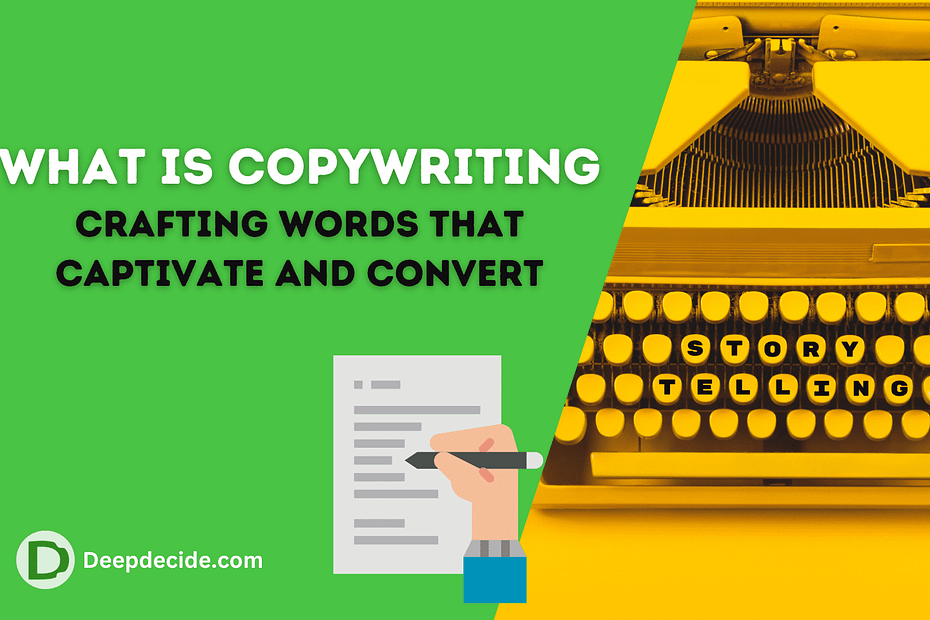Last Updated on: 30th November 2023, 12:44 pm
In the fast-paced world of business and marketing, the power of words can never be overstated.
Masterfully crafted words that inspire action and captivate audiences are often the difference between building a successful brand and fading into obscurity.
This art of persuasive writing is otherwise known as copywriting.
What is Copywriting?
At its core, copywriting is the process of crafting compelling written content that prompts readers to take a specific action.
This could mean buying a product, subscribing to a service, pledging towards a cause, or any other consumer-driven action.
Copywriting seeks to persuade the reader, listener, or viewer to act and to promote brand awareness.
The Role and Importance of Copywriting
Copywriting permeates every aspect of a business. From website content and blog articles to letters, emails, social media updates, and even video scripts.
The aim of good copy is not just to sell a product or service; it aims to tell a story, evoke emotions, and forge a lasting connection between a brand and its audience.
Fundamental Elements of Copywriting
- Clear Message: The first principle of copywriting is clarity. You want to make sure your message is not lost in complex sentences and industry jargon. The reader should immediately grasp what you’re offering and why it’s valuable to them.
- Targeted Audience: Context is key. Good copy reflects a deep understanding of its audience. It should address the audience’s specific needs, desires, fears, and expectations.
- Persuasive Power: A great copy entices the reader to act. It convinces them that they need your product or service.
- A Touch of Creativity: Good copy is both persuasive and enjoyable to read. A fun, engaging, or emotive writing style can enhance your brand’s image and keep readers interested.
- Strong Call to Action: The best copies end with a strong call-to-action, urging the reader to take a specific, meaningful step towards becoming a customer.
The Role of SEO in Copywriting
In digital marketing, copywriting goes hand in hand with Search Engine Optimization (SEO). An SEO copywriter incorporates keywords into the text to help the copy rank higher in search engine results.
This practice makes the website more visible to potential customers, attracting more traffic and optimizing conversions.
Different Types of Copywriting
Copywriting encompasses a broad range of mediums, each necessitating a distinct approach. Every type aims to connect, persuade, and compel, but the methods can differ strikingly.
- Advertising Copywriting: This is perhaps what most people think of when they hear ‘copywriting.’ It involves creating catchy slogans, jingles, or taglines for print, TV, radio, or digital ads.
- SEO Copywriting: This type involves crafting compelling content that ranks well in search engine results. Utilizing researched keywords, an SEO copywriter creates engaging content that attracts organic traffic.
- Website Copywriting: This kind of copywriting focuses on creating captivating content for a website. It includes homepage content, ‘About Us’ page, product descriptions, landing pages, and more.
- Sales Copywriting: Sales copy aims to persuade potential customers to purchase a product or service. A sales copy may form part of a direct mail campaign, a sales brochure, or a product description.
- Content Copywriting: This form of copywriting is all about providing valuable content to the audience, usually in the form of blog posts, articles, guides, and tutorials.
The Anatomy of a Great Copy
Great copywriting goes beyond being grammatically correct. It comprises a compelling headline to hook the reader, a persuasive body to convey the central message, and an impactful call to action (CTA) that motivates the audience to act.
- Headline: The headline sets the stage for your copy. An effective headline should immediately grab the reader’s attention and entice them to continue reading.
- Body: This is where you deliver your primary message. A persuasive body should offer value, address the reader’s needs or pain points and present your product or service as a solution.
- Call to Action (CTA): A great copy ends with a compelling CTA. It should clearly instruct the reader on what actions to take next – visit a website, buy a product, sign up for a newsletter, and so forth.
Effective Copywriting Techniques
There isn’t a one-size-fits-all approach to crafting captivating copy. However, several tested and proven techniques can drive your copywriting success:
- The AIDA Principle: This classic marketing model stands for Attention, Interest, Desire, and Action. First, grab the reader’s attention. Then, generate interest in what you’re offering. Following that, create a desire for the product or service and finally, induce an action that completes the sales process.
- The Power of Storytelling: Stories have the ability to capture attention, stir emotions, and create a personal connection with the readers. Incorporating storytelling into your copywriting can make your content more engaging.
- Understanding the Customer’s Journey: By understanding the stages your customer goes through — awareness, consideration, and decision — you can craft a narrative that guides them through the buying process, making it an effortless and enjoyable experience.
- Highlighting the Benefits, not just the Features: While describing the features of a product or service is crucial, highlighting the benefits can attract and persuade customers more effectively. People want to understand how your product or service can improve their lives.
- Solving the Problem: Great copy always presents a problem and then provides a solution. By addressing the challenges or pain points of your audience, you show empathy and build trust, which can lead to increased conversions.
Adapting Copywriting to Different Platforms
Each medium or platform that you write for requires a different approach. Understanding the specifics of each can help you tailor your copy to fit the context and audience:
- Website Copywriting: This should be concise, engaging, SEO-friendly, and should represent the brand voice effectively to captivate site visitors.
- Email Copywriting: This should be personalized, concise, value-loaded with a compelling subject line to assure high open and click-through rates.
- Social Media Copywriting: This should be engaging, interactive, shareable, and aligned with the trends and tone of the specific platform.
- Ad Copywriting: This should be sharp, value-driven, and action-oriented to capture attention and prompt quick responses.
The Essential Tools for Copywriting
Effective copywriting isn’t just about having a way with words. You also need to arm yourself with the right tools to refine your craft.
These can range from helpful software to must-read books and resources for learning:
- Grammar and spelling checkers: Tools like Grammarly can help ensure that your work is grammatically correct and free of spelling errors.
- SEO tools: SEO is a key part of digital copywriting. Tools like Yoast SEO, Moz, and SEMRush can help optimize your copy so it ranks higher in search engine results.
- Thesaurus and dictionaries: An essential resource for any writer is a good thesaurus or dictionary. These can assist you in finding the right words and phrases to capture your ideas effectively.
- Books: There are numerous books on copywriting that can help broaden your understanding and enhance your skills. Some of these include “The Copywriter’s Handbook” by Robert W. Bly, “Made to Stick” by Chip and Dan Heath, and “Hey Whipple, Squeeze This!” by Luke Sullivan.
- Online courses: Online platforms like Coursera, LinkedIn Learning, and Skillshare offer a plethora of copywriting courses for different proficiency levels.
Maintaining Ethics in Copywriting
With the persuasive power of copywriting comes great responsibility. Ethical considerations should play a guiding role in any copywriter’s work:
- Truthfulness: Avoid making false or misleading claims. This not only harms your brand reputation but can also lead to legal repercussions.
- Privacy: Respect privacy laws and regulations in the collection and use of customer data. Transparency about data usage helps build trust with audiences.
- Cultural Sensitivity: Your copy should respect and value cultural differences. Avoid stereotyping and other offensive content.
Copywriting tools
In the world of copywriting, there are scores of tools that help writers produce high-quality and effective content.
From researching and creating content to editing and SEO optimization, these tools are designed to assist at every step of a copywriter’s journey.
- copy.ai
- Wordtune
- Copysmith
- Wordsmith
- Writesonic
- WordAi
- ClickUp
- Perplexity
- Mangools Google SERP Simulator
- ChatGPT
- Buzzsumo
Learning from the Best in the Industry
One of the best ways to sharpen your copywriting skills is to learn from those who have already mastered the craft.
Legendary copywriters such as David Ogilvy, Eugene Schwartz, and Leo Burnett have left behind a treasure trove of teachings and insights for us to learn from.
By observing their work and learning from their experiences, budding copywriters can gain invaluable insights and lessons.
The Final Word: Practice Makes Perfect
Mastering the art of copywriting requires continuous learning and practice. It’s through writing, getting feedback, and refining your work that you truly hone your skill.
As the business world continues to recognize the immense power of words, the demand for skilled copywriters is only set to rise.



